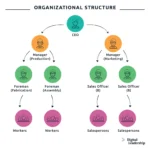English equivalent: Augmentation Hypothesis in Leadership
The Augmentation Thesis posits that the effectiveness of leadership can be significantly enhanced when transformational leadership is integrated into existing transactional leadership practices. This theory—also called the Growth Thesis—suggests that transformational behaviors augment the effectiveness of traditional, exchange-based leadership by inspiring employees to reach higher levels of motivation and performance.
Transactional vs. Transformational Leadership
Transactional leadership is based on a structured exchange relationship, where employees are rewarded for meeting specific goals or expectations. This “give-and-take” approach emphasizes process efficiency, clear responsibilities, and performance-based rewards. It is focused on achieving existing organizational objectives, not necessarily expanding or redefining them.
In contrast, transformational leadership centers on the leader’s ability to inspire, motivate, and intellectually stimulate employees. Through vision, charisma, and personalized attention, transformational leaders elevate their followers’ aspirations—leading to deeper commitment and the pursuit of higher-order goals that go beyond contractual obligations.
This transformation results in increased intrinsic motivation, innovation, and enhanced group cohesion. As a result, transformational leadership achieves outcomes beyond what is expected from purely transactional approaches.
Bass’s Augmentation Model
Introduced by Bernard M. Bass (1985), the augmentation thesis is grounded in both empirical research and historical case studies of leaders such as John F. Kennedy, George Patton, and Charles de Gaulle. Unlike James MacGregor Burns (1978), who viewed transformational and transactional leadership as opposing ends of a continuum, Bass argued that transformational leadership is complementary—not contradictory—to transactional leadership.
Bass identified four dimensions of transformational leadership:
-
Charisma (Idealized Influence): The leader serves as a role model, earning trust and respect.
-
Inspirational Motivation: Communicating a compelling vision that energizes and excites followers.
-
Individualized Consideration: Recognizing individual employee needs and providing tailored support (see qualification).
-
Intellectual Stimulation: Encouraging innovation, critical thinking, and problem-solving.
Measuring the Augmentation Effect
The Multifactor Leadership Questionnaire (MLQ)—developed by Bass (1985) and later refined with Avolio (1990)—is the primary tool used to empirically evaluate the augmentation thesis. The MLQ assesses:
-
Transformational leadership dimensions (charisma, motivation, appreciation, stimulation)
-
Transactional leadership behaviors (contingent reward, passive management-by-exception)
-
Laissez-faire leadership as a baseline of ineffective leadership
This validated instrument allows both self-assessment and external assessment, offering detailed insights into individual, team, and organizational leadership practices (see Scholz 2000).
Critiques and Empirical Support
Numerous empirical studies—such as Lowe, Kroeck & Sivasubramaniam (1996), Geyer & Steyrer (1998), and Felfe (2008)—have partially confirmed the validity of the augmentation hypothesis. However, criticisms have been raised about:
-
The methodological robustness of the MLQ scales
-
The lack of contextual differentiation in early models
-
The initial failure to consider varying task characteristics and leadership situations
Bass addressed many of these concerns in later works, such as Bass (1999), by elaborating on the environmental and organizational conditions under which transformational leadership is most likely to emerge and be effective.
« Back to Glossary Index





![15 Employee Offboarding Templates That Save Hours of HR Time [Free Downloads] 15 Employee Offboarding Templates That Save Hours of HR Time [Free Downloads]](https://i1.wp.com/www.hrcloud.com/hubfs/Header.png?w=150&resize=150,100&ssl=1)
